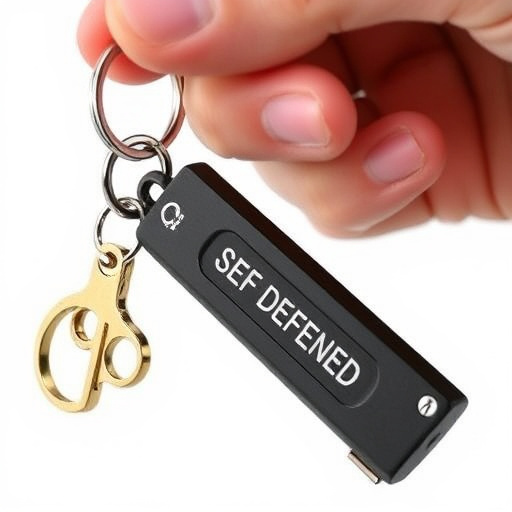Keychain self-defense, a popular personal safety measure, varies in legality across states, with some permitting reasonable force using non-lethal tools while others have stricter rules. Understanding legal pressure points and adhering to state guidelines is crucial for safe and effective use. U.S. states have unique regulations regarding defensive keychains, ranging from strict prohibitions to lenient stances, requiring individuals to research local laws, especially when traveling. Balancing effectiveness with practicality and following proper handling techniques ensures reliable and legal keychain self-defense using pressure targets.
In today’s unpredictable world, individuals are seeking practical ways to protect themselves. One such tool gaining popularity is the defensive keychain—a compact self-defense device that can fit discreetly on a keyring. This article explores the legal aspects of carrying such keychains, focusing on understanding when and where it’s permissible to ‘pressurize’ targets for self-defense. We’ll delve into state-specific guidelines and practical considerations for safe and legal carry, empowering readers with knowledge crucial for their safety.
- Understanding Keychain Self-Defense: A Legal Perspective
- Pressuring Targets: When and Where is it Legal?
- State-Specific Guidelines for Carrying Defensive Keychains
- Practical Considerations for Safe and Legal Carry
Understanding Keychain Self-Defense: A Legal Perspective
Keychain self-defense, a concept that has gained traction in recent years, involves carrying a small, easily accessible device designed to deter or incapacitate an attacker. This practice raises important legal considerations regarding personal safety and the use of force. When discussing keychain self-defense from a legal perspective, understanding the concept of pressure targets becomes crucial. These are specific areas on an assailant’s body intended to cause pain, disorientation, or temporary incapacitation, enabling the user to escape or summon help.
The legality of keychain self-defense and its associated pressure points varies across jurisdictions. Some states explicitly allow citizens to use reasonable force, including non-lethal tools like keychains, for self-protection. However, others have stricter regulations, defining the types of force permissible based on the level of threat. Keychain users must be aware of these legal boundaries to ensure their actions remain within the law. Additionally, proper training in self-defense techniques and pressure point applications is essential to promote safe and effective use.
Pressuring Targets: When and Where is it Legal?
In the realm of keychain self-defense, understanding when and where it’s legal to pressure targets is paramount. Unlike traditional weapons, keychains are often considered less threatening, but their use in self-defense scenarios can be complex. In many states, pressing a target with a keychain is permissible under certain circumstances, typically when it’s used to deter or escape an imminent threat. This tactic is most viable in public spaces where there’s ample room for movement and the action doesn’t endanger bystanders.
However, there are strict guidelines to follow. Using excessive force or targeting vulnerable areas like the eyes or throat can be illegal and may result in serious injury or legal repercussions. It’s crucial to familiarize yourself with your state’s specific laws regarding keychain self-defense, as regulations vary widely. Knowing the legal boundaries ensures you’re prepared for a potential encounter while adhering to the law, making it an effective yet responsible tool for personal safety.
State-Specific Guidelines for Carrying Defensive Keychains
In the United States, each state has its own set of regulations regarding the legal carrying of defensive keychains, also known as pressure targets. These guidelines vary widely, from strict prohibitions to relatively lenient stances, reflecting the differing perspectives on self-defense and concealed weapons across the nation. Understanding these state-specific rules is crucial for individuals looking to legally carry a keychain designed for self-defense.
For instance, some states allow defensive keychains as long as they meet certain criteria, such as being non-lethal and carried in a secure manner. Other states might classify them as concealed weapons, subjecting owners to the same regulations as firearm carriers, including background checks and permit requirements. Keychain self-defense users should thoroughly research their state’s laws, especially when traveling between jurisdictions with different pressure target policies.
Practical Considerations for Safe and Legal Carry
When considering a keychain self-defense tool, it’s crucial to balance effectiveness with practicality for safe and legal carry. These tiny devices often pack a punch in terms of defense capabilities, utilizing pressure targets to disable or deter attackers. However, users must be mindful of local laws and regulations regarding concealed weapons, ensuring they comply with state or regional restrictions on self-defense tools.
Safe handling is equally important. Users should familiarize themselves with proper techniques for deploying the keychain defense tool, practicing in controlled environments to build muscle memory. Regular maintenance and storage in a secure location are also essential to keep the device in optimal condition, ready when needed.
Understanding the legal nuances surrounding keychain self-defense, particularly when applying pressure to targets, is crucial. This article has navigated state-specific guidelines, offering insights into where and when carrying a defensive keychain is legally permitted. By considering practical aspects of safe and legal carry, individuals can empower themselves while adhering to their jurisdiction’s requirements. Remember that staying informed about local laws and prioritizing safety is key when it comes to keychain self-defense.
